Lionel introduced the 800 series cars in 1926. These were the top of the line freight cars until the scale and semiscale cars were introduced in 1940. The first series of cars have brass plates and trim, and latch couplers.
In 1934 Lionel began converting the trim to nickel and changing the colors of the cars. Between 1934 and 1936 these cars came with a mixture of brass and nickel trim. These mixed trim or notch cars (because they fit in the notch years 1935 and 1935) can be a lot of fun to collect. Because most of these notch cars can be created by changing parts with other cars, collectors should examine the car for evidence of being taken apart before paying a premium for a notch car.
In 1935, Lionel introduced the box coupler, and many notch cars can be found with either a latch or a box coupler. By 1936 the trim was nickel on all the cars.
In 1938 Lionel introduced the Automatic box coupler. This coupler has a magnet that opens the coupler at the push of a button when the car is positioned over a remote control track section. Lionel added a 2 to the front of the train number to denote remote control couplers. Thus the 800 series became the 2800 series. Lionel cataloged most of these cars in manual and remote control versions through 1942 when train manufacturing was dropped due to the war effort.
In 1940, Lionel began to paint the cars in flatter, more realistic colors, and dropped the nickel plates in favor of heat stamped lettering. Heat stamping is done by heating an inked metal stamp then pressing it to the car side. Most collectors refer to these as “rubber-stamped” cars. While this is technically incorrect (a rubber stamp does not impress the paint leaving ridges around the stamp) I follow this convention out of habit. Some cars can be found with nickel plates in the later rubber stamped colors. These 1940 notch cars are the most difficult cars to find in the series. Lionel did not make the 800 series cars after world war 2.
Car Frames:
There were four different types of frames used on the 800 series cars.
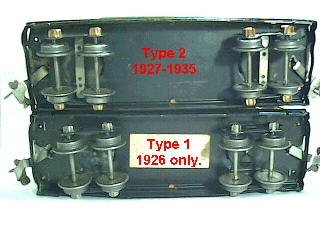 |
Type 1 Frame 1926 only
The earliest frames are called Short Wheel Base frames because the wheels are closer together. The short wheel base (Type 1) frames were only used in 1926. Cars with Type 1 frames are very hard to find, but they don’t command a large premium in price because they are the same color as the later Type 2 frame.
Type 2 Frame 1927-1935
The Type 2 frame (shown on top of the Type 1 frame in the picture above) was introduced in 1927 and was used until 1935. An easy way to tell a type 1 frame from a type 2 is by where the journals line up with the three rivets on the frame. On type 1 frames the outside journals are between the inner and middle rivet, on type 2 frames the outside journals are between the outer and middle rivet.
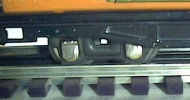 Type 1: journal is between inner and middle rivet. | 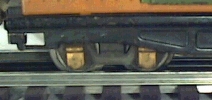 Type 2: Journal is between outer and middle rivet. |
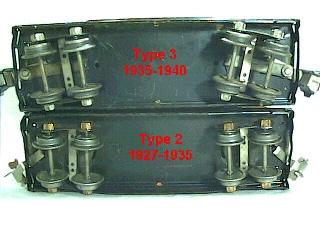
Type 3 Frame 1935-1940
The Type 3 frame has the same wheel spacing as a type 2 frame but the oval shaped hole the latch coupler attaches to is replaced with a small slot for a pivot point, the truck pivot arc is gone and the frame is now indented around the truck mounting hole.
The indented ring around the truck mounting hole is only slightly depressed- about the thickness of a dime.
A type 3 frame is shown sitting on top of a type 2 frame in the photo to the right.
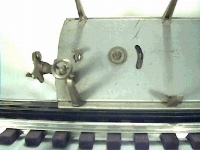 Type 2 Frame has oval hole for coupler and slotted arc. | 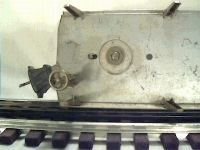 Type 3 Frame has slot for 2 rib coupler and quarter sized depression around truck mounting hole. |
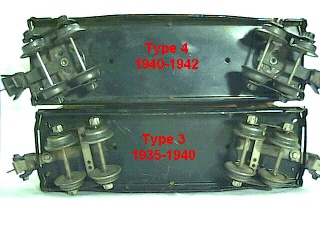
Type 4 Frame 1940-1942
The Type 4 frame was introduced in 1940. Lionel was changing their train line to be more realistic. The trucks are moved out father toward the car ends, and because the newer lower trucks were used a dished out depression 1/4 inch deep was formed around the truck mounting hole so the frame would ride at the same height as the earlier cars. The photo to the right shows a type 4 on top of a type 3. For a side by side comparison see the 3859 pictures.
The type 4 frame was used on the rubberstamped cars and on the even rarer 1940 notch cars. This was the last frame Lionel used for these cars, and cars with these frames and later trucks are the best running tinplate cars.
I will add a page showing the different types of trucks in the future.
Here’s links to the car pages:
- Lionel 810 Crane Car
- Lionel 811 Flat Car
- Lionel 812 Gondola
- Lionel 813 Stock Car 1926-42
- Lionel 814R Refrigerator Car 1929-42
- Lionel 814 Boxcar 1926-42
- Lionel 815 and 2815 Tank Cars 1926-42
- Lionel 816 and 2816 Hopper Cars 1926-42
- Lionel 817 Caboose
- Lionel 820 Searchlight Car
- Lionel 2810 Crane Car
- Lionel 2811 Flat Car
- Lionel 2812 Gondola
- Lionel 2813 Stock Car 1938-42
- Lionel 2814R Reefer Car 1938-42
- Lionel 2814 Boxcar 1938-42
- Lionel 815 and 2815 Tank cars 1926-42
- Lionel 816 and 2816 Hopper Cars 1926-42
- Lionel 2817 Caboose
- Lionel 2820 Floodlight Car
- Lionel 3814 Automatic Merchandise Boxcar
- Lionel 3859 Automatic Dump Car